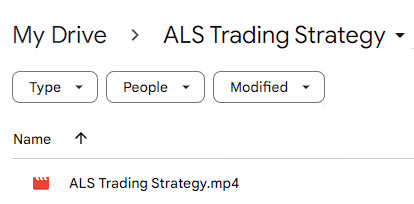*** Proof of Product ***

Exploring the Essential Features of “ALS Trading Strategy”
The ALS Trading Strategy focuses on understanding the dynamics of liquidity and inducement within the market, particularly for the EUR/USD currency pair, often called “Fiber.” This advanced approach is designed for traders looking to refine their skills in reading market behavior, identifying high-probability setups, and avoiding traps commonly triggered by market manipulation.
ALS Trading Strategy Overview
1. Introduction to ALS Trading Strategy
Overview: The ALS Trading Strategy aims to deepen traders’ knowledge of market dynamics by focusing on how liquidity and inducement influence price movement. The strategy emphasizes market structure analysis, identifying key liquidity zones, recognizing inducement traps, and reading price action patterns.
Key Components:
- Market Structure Analysis
- Liquidity Zone Identification
- Inducement Traps
- Price Action Patterns
Goals:
- Enhance traders’ ability to identify high-probability trade setups.
- Reduce false breakouts and market manipulation traps.
- Provide a structured approach for entering and exiting trades.
2. Understanding Liquidity in Trading
What is Liquidity? Liquidity refers to the availability of buyers and sellers in the market. High liquidity is characterized by a large volume of orders on both sides, leading to tighter spreads and smoother price movements, while low liquidity can cause wider spreads and increased volatility.
Liquidity Zones:
- Definition: Areas where a significant number of orders accumulate, such as support/resistance levels, previous highs/lows, and round numbers.
- Importance: Liquidity zones are crucial as large institutions and smart money often place orders here, making these areas potential turning points in the market.
Key Points:
- Liquidity Pools: Regions where stop orders cluster, acting as magnets for price movement, often targeted by institutions.
- Liquidity Squeeze: Occurs when price rapidly moves towards a liquidity pool, filling orders quickly and potentially causing sharp reversals.
3. The Concept of Inducement in Trading
What is Inducement? Inducement involves luring traders into taking positions in the wrong direction, leading to premature entries or exits. This market manipulation often misleads retail traders with false signals, setting them up to be caught on the wrong side of the trade.
Common Inducement Traps:
- False Breakouts: When price breaks key levels only to reverse quickly, usually near liquidity zones with clustered stop orders.
- Overbought/Oversold Signals: Indicators like RSI may show extreme conditions, tempting traders into counter-trend positions while the market continues its original direction.
Key Points:
- Inducement Candles: Specific candlestick patterns that entice traders into positions, typically showing sharp moves followed by reversals.
- Inducement Zones: Areas just beyond liquidity zones or near the end of trends where inducement is likely to occur.
4. Combining Inducement and Liquidity in ALS Trading Strategy
How They Work Together: The ALS strategy integrates liquidity and inducement, helping traders anticipate where traps might be set. By aligning liquidity zones with potential inducement areas, traders can strategically enter and exit trades.
Steps to Implement:
- Identify Liquidity Zones: Mark key levels where liquidity is concentrated, such as previous highs/lows, support/resistance, and psychological levels.
- Look for Inducement Traps: Identify signs of inducement like false breakouts or sharp moves that lure traders into positions.
- Wait for Confirmation: Avoid immediate entries at liquidity zones. Wait for price action confirmation through rejection candles or reversal patterns.
- Place Trades: Enter trades in the direction opposite of the inducement, capitalizing on reversals or trend continuations.
Benefits:
- Enhanced Trade Accuracy: By waiting for inducement to unfold and using liquidity as a guide, trade accuracy improves.
- Reduced False Signals: The strategy filters out false breakouts and traps, leading to fewer losses.
- Better Risk Management: Identifying liquidity zones allows for more strategic stop-loss placements, minimizing premature exits.
5. Conclusion
The ALS Trading Strategy’s focus on Inducement and Liquidity offers a sophisticated framework for Forex trading. By mastering these concepts, traders can better anticipate market movements, avoid common pitfalls, and execute trades with greater confidence. Whether you are an experienced trader refining your skills or a beginner eager to learn advanced techniques, this strategy provides valuable insights into market behavior, enhancing your overall trading performance.
Please see the full list of alternative group-buy courses available here: https://lunacourse.com/shop/









